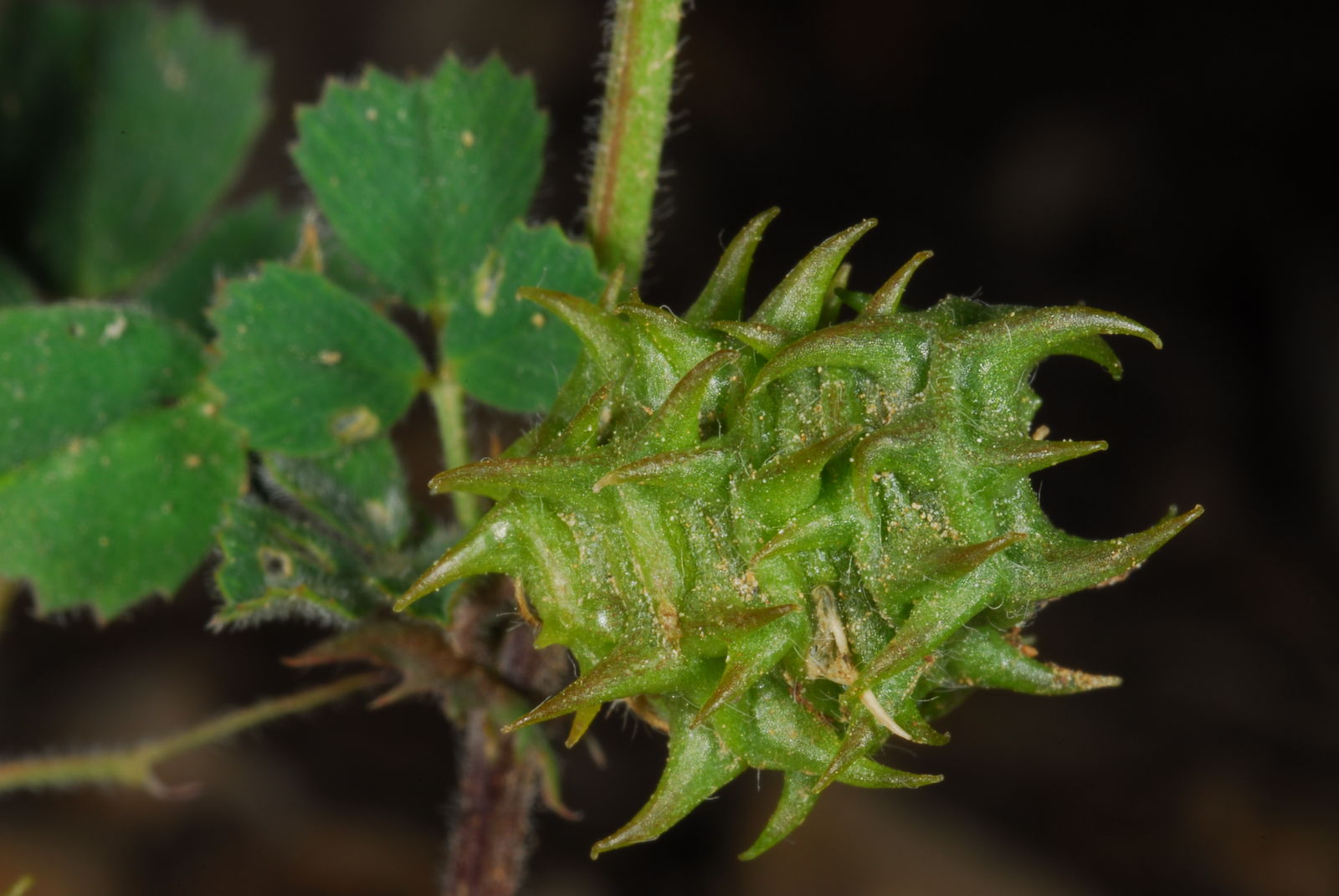Barrel Medic, Barrel Clover
medicago truncatula
Also known as: ["Barrel Clover","Barrel Medic"]
Overview
A small annual legume native to the Mediterranean region, valued for its nitrogen-fixing ability and use in genetic research.
Benefits & Perks
["drought tolerant","wildlife attractant (bees, butterflies, birds)","nitrogen fixing"]
Botanical Classification
| Phylum: | Magnoliophyta |
| Class: | Magnoliopsida |
| Order: | Fabales |
| Family: | Fabaceae |
| Genus: | Medicago |
| Botanical Name: | Medicago truncatula |
Plant Characteristics
Basic Information
- Category: Herbs & Weeds
- Suitable Location: outdoor garden bed or container in a sunny spot
- Suitable For:
- Is Weed: No
- Allergenicity: low
Environmental Needs
- Climate: {"temperatureRange":"5–35°C"}
- Hardiness: {"zones":"8–10"}
- Misting: rarely required, only if ambient humidity is very low
- Drainage: Fast-draining to prevent waterlogging.
- Soil Type: Well-draining, loamy soil with added organic matter.
Maintenance Level
- Maintenance Level: low
- Toughness Level: moderate
- Pruning Frequency: As needed, typically every 2–3 months or after flowering.
- Pruning Intensity: Light to moderate; avoid heavy pruning unless necessary.
Care Details
Ideal Sunlight Coverage:
Full sun (6–8 hours/day); tolerates partial shade in hot climates.
Sunlight Tolerance Tips:
Acclimate gradually to intense sunlight; protect from harsh midday sun; adjust placement based on seasonal light changes.
Care Requirements
Care Difficulty
easymoderate
Sunlight
full sun to partial shade
Rotate plant for even light; use sheer curtains in intense sun; avoid direct afternoon sun in summer.
Watering
every 7–10 days during active growth, reduce in winter
Water thoroughly but infrequently; ensure soil dries between waterings; avoid overwatering.
Soil
well-drained, sandy loam with moderate organic content
pH: Slightly acidic to neutral (6.0–7.0).
Ensure soil is not compacted; avoid heavy clay mixes; use a mix with good aeration.
Temperature
Prefers 60–75°F (15–24°C); tolerates mild frosts but avoids extreme heat.
Avoid sudden temperature shifts; protect from drafts; maintain moderate humidity.
Fertilizing
every 4–6 weeks during growing season, avoid in winter
Apply fertilizer after watering; flush soil occasionally to prevent salt buildup; stop fertilizing in dormancy.
Propagation
Methods
Stem cuttings or seed; stem cuttings are faster and more reliable.
Step-by-Step Propagation Guide
- Take cutting.
- Apply hormone.
- Plant in medium.
- Maintain humidity.
- Wait for roots.
Best Time: Spring or early summer when growth is active.
Environment
High humidity, indirect light, and warm temperatures (70–75°F).
Medium
Well-draining mix like perlite and peat moss.
Hormone
Rooting hormone is recommended for faster rooting.
Timeline
Roots in 2–4 weeks; establish in 2–3 months.
Tools Needed
Pruners, rooting hormone, small pots, humidity dome.
Quick Tips
Use healthy, non-flowering stems; keep soil consistently moist; provide bottom heat for faster rooting.
Pruning & Repotting
Pruning Guide
Method
Pinch back tips or cut just above a leaf node to promote branching.
Pruning Plan
Remove dead or leggy growth to encourage bushier form; shape as needed.
Tools
Clean, sharp pruners or scissors.
Checklist
Sanitize tools; prune dead/damaged growth; shape plant; avoid over-pruning.
Repotting Guide
Best Season
Spring, before active growth begins.
Pot Size
Move to a pot 1–2 inches larger in diameter.
Method
Remove plant gently; trim roots if needed; use fresh soil mix; ensure good drainage.
Suggestions
Repot every 1–2 years or when roots fill the pot; promotes fresh soil and growth.
Checklist
Check root bound status; prepare new pot; use fresh soil; water after repotting.
Advanced Care Tips
Watering Mastery
Watering Checklist
Check soil moisture; water deeply; ensure drainage; avoid wetting leaves.
How to Apply Water Properly
Water at the base of the plant, ensuring moisture reaches the root zone; allow excess water to drain away; water in the morning to reduce evaporation.
Watering Schedule Tips
Water deeply once the top inch of soil is dry; reduce frequency in winter to prevent root rot.
Soil Improvement
Add perlite or sand for drainage; incorporate compost for fertility.
Temperature Stress Management
Signs of Temperature Issues
Wilting, yellowing leaves, stunted growth, or bud drop.
Cold Stress
Slows growth, may cause leaf discoloration or dieback in prolonged cold.
Solution: Provide frost protection; move indoors in freezing temperatures; ensure good air circulation.
Hot Stress
Leaves may scorch, wilt, or drop; growth may slow in excessive heat.
Solution: Provide shade during peak heat; increase watering; use mulch to retain soil moisture.
Fertilizing Guide
Fertilizing Checklist
Check fertilizer type; dilute correctly; apply during active growth; avoid winter feeding.
Fertilizing Method
Use balanced liquid fertilizer diluted to half strength every 4–6 weeks during growing season; avoid fertilizing in winter.
Common Problems & Solutions
Toxicity Warning
Cats
Non-toxicMedicago truncatula is not toxic to cats. It is generally safe for cats to ingest or come into contact with this plant.
⚡ Toxic If:
None
Dogs
Non-toxicMedicago truncatula is not toxic to dogs. It is generally safe for dogs to ingest or come into contact with this plant.
⚡ Toxic If:
None
Humans
Non-toxicMedicago truncatula, commonly known as barrel medic, is not considered toxic to humans. It is a leguminous plant often used in research and as a forage crop.
⚡ Toxic If:
None
Frequently Asked Questions
Q: Is Medicago truncatula edible?
A: While not commonly consumed, it is non-toxic and can be used as forage for livestock.
Q: Does Medicago truncatula fix nitrogen?
A: Yes, it forms symbiotic relationships with rhizobia to fix atmospheric nitrogen.
Q: Is Medicago truncatula invasive?
A: It can become weedy in some regions but is generally not considered highly invasive.
Quick Reference
| Family: | Fabaceae |
| Care: | easy |
| Light: | full sun to partial shade |
| Water: | every 7–10 days during activ |
Get Expert Care Tips
Download the Plantious app for personalized care reminders and plant identification!
Google Play App Store







